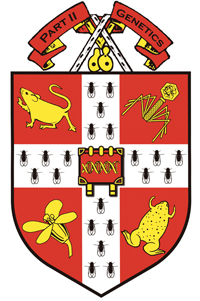We do not have a formal reading list of incoming Part IIs. A lot of reading material is recommended by the various lecturers during the course, but most of this will be primary research papers and up-to-date reviews, rather than textbooks. Attempting to tackle this material before the lectures start would probably not be very useful (and quite possibly, off-putting!)
Revision/Background IA and IB Course Content on Moodle
During the Part II course, lecturers will regularly use basic genetics terminology and will often refer to techniques used to study molecular, cellular and developmental biology. In general, lecturers will not have time to go through these areas in detail during lectures and supervisions but will assume that you are familiar with the material from your own IA and IB courses. We strongly recommend, that if you are a NatSci, you refresh your memory of the information introduced to you in the NST IA Biology of Cells and IB Cell and Developmental Biology courses, since in many cases this information will be built upon at Part II. If you are a pre-clinical Medic or Vet, we recommend that you re-read the Lent Term genetics lectures delivered in the IA MIMS course (Murchison, and Farr) and (for Medics) those given by Karam Teixeira in the IB HR course.
You find particularly useful:
IA Cells
IA Biology of Cells is a little reminiscent of IA MIMS, introducing many aspects of molecular and cellular biology and genetics:
- Miska/ Summers: Hunting the Gene lectures, covers basic genetics.
- Russell: The Genetic Revolution. The handout also includes a Glossary of Terms that you may find useful over the course of the year.
- Segal: Cell Proliferation, useful preparation for Module 1.
IB CDB
We recommend that those of you who have not taken CDB read the lecture notes, and those of you who have taken CDB re-read some of them, especially the following:
- Baker/ Summers: Genetics Systems of Prokaryotes. Strategies of gene expression and organisation in prokaryotes: the prokaryotic cell cycle, nucleoid, prokaryotic genomes (chromosomes and plasmids) and the genetic flexibility of prokaryotes.
- O'Kane: Eukaryotic Genome Organisation and Function: genome content, repetitive sequences and mobile elements, plus genome engineering strategies for studying cell biology and development. Cahir's lectures introduce many of the techniques routinely used and you may find it useful to refer to these lectures during the year [e.g. sequencing (including NGS), southern, northern, western blotting, PCR, DNA microarrays, SNPs, GWAs, RNAi, CRISPR-Cas9, gene targeting & transgenesis, forward and reverse genetics]. His second CDB lecture block (Coordination of Organelle & Cellular Function) introduces autophagosomes, lysosomes, the endoplasmic reticulum and mitochondria , plus super-resolution microscopy.
- Segal: Cytoskeleton & Mitotic Cell Division. The eukaryotic cytoskeleton and its role in shape, motility and mitotic cell division.
You will also find useful the Easter Term CDB lectures on development:
- Steventon: Xenopus & Zebrafish Development.
- Moris: Mammalian Development.
Reading these should help you prepare for Module 2, Early Development & Patterning.
IA EB
All incoming students are given access to the NST IA course Evolution and Behaviour, which students find provides a helpful introduction to material in our Lent Term Module 4, Evolutionary Genetics & Adaptation. The most relevant material is covered in the block of 8 lectures, delivered by Dr John Welch, that introduce evolutionary genetics.
Review articles, books and videos covering key concepts
Genetic Screens
From a series of reviews into "The Art & Design of Genetic Screens" in Nature Reviews Genetics, we have picked out two which should be useful:
- Forsburg (2001) The Art and Design of Genetic Screens: Yeast. Nature Reviews Genetics 3:176-188/ doi:10.1038/nrg751
The art and design of genetic screens: yeast | Nature Reviews Genetics - St Johnston (2002) The Art and Design of Genetic Screens: Drosophila. Nature Reviews Genetics3: 176-188. doi10.1038/nrg751
nrg751.pdf (nature.com)
CRISPR-Cas9 and RNAi Technologies
Barrangou et al (2015) Advances in CRISPR-cas9 genome engineering: lessons learned from RNA interference. Nucleic Acids Research 43(7): 3407-3419.
Advances in CRISPR-Cas9 genome engineering: lessons learned from RNA interference | Nucleic Acids Research | Oxford Academic (oup.com)
Yeast Genetics
The Nobel Prize acceptance speech delivered in 2001 by Sir Paul Nurse, in which he talks about his work on the cell cycle using yeast genetics.
The official website of the Nobel Prize - NobelPrize.org
Developmental Genetics
- The Animal Kingdom: A very short Introduction (OUP) by Peter Holland. It goes over animal classification, phylogeny, body plans, and development in an accessible way. An online version is accessible via the UL iDiscover site, https://idiscover.lib.cam.ac.uk/.
- Wolpert, Tickle & Martinez-Arias, Principles of Development (OUP) – a good overview. No e-book is currently available, but some parts can be accessed through books.google.co.uk. A paper copy of this book is available in the Genetics Library for everyone to refer to during the year. [An alternative (but older, ed. 2011) text, that is accessible online via the UL iDiscover site, https://idiscover.lib.cam.ac.uk/ is: Wolpert, Developmental Biology: a very short introduction. Oxford University Press).]
Evolutionary Genetics
- Charlesworth & Charlesworth, Evolution: A Very Short Introduction. Oxford University Press, (a useful introduction to Module 4). 2017 ed. is available as an e-book via UL iDiscover.
- Barton et al. (2007) Evolution. Cold Spring Harbor Laboratory Press.
Evolution (cshlpress.com)
Excellent, general interest, genetics-orientated books are:
Mukherjee, The Gene: an intimate history, Simon & Schuster.
This book will bring alive much of the genetics material discussed in the IA Cells and MIMS lecture courses/we strongly recommend finding a copy to read over the summer. There is also an excellent video series based on this book available via Kanopy: https://www.kanopy.com/en/cam/watch/video/11345307/11345309
Arney, Rebel Cell: Cancer Evolution and the Science of Life, BenBella Books.
All books listed above are available for reference in the Genetics Library. Some are also available as e-books via the iDiscover page: https://idiscover.lib.cam.ac.uk/
Page updated 31/07/2025

